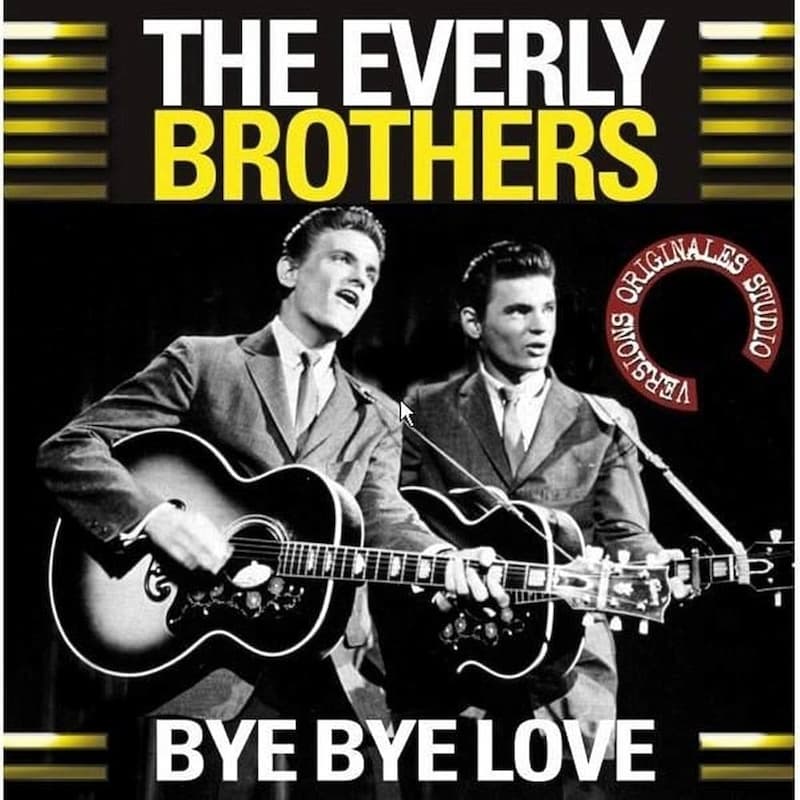
In 1957, the musical world witnessed the birth of an iconic track that would ripple across the genres of rockabilly, country, and early rock and roll — “Bye Bye Love.” Crafted by the dedicated husband-and-wife songwriting team, Felice and Boudleaux Bryant, this song marked the start of an extraordinary journey for the young duo, The Everly Brothers, Don and Phil Everly.
Recorded in the heart of Nashville, Tennessee at RCA Studios under the sharp production eye of Archie Bleyer for Cadence Records, this debut single was nothing short of explosive. Launched in April 1957 with the B-side titled “I Wonder If I Care as Much,” the song was later featured on their inaugural album, The Everly Brothers, released in May. The track, lasting just two minutes and twenty seconds, is a masterful blend of catchy acoustic guitar riffs entwined with the duo’s hallmark close-harmony vocals that captured the vibrant pulse of a musical era just shifting into something new.
The public’s response was monumental. Entering the Billboard Top Pop Singles chart at number 73 on May 27, the single ascended swiftly, peaking at number 2 by July 8, 1957. However, it was famously blocked from the top spot by none other than Elvis Presley’s “(Let Me Be Your) Teddy Bear.” Remaining on the chart for an impressive 22 weeks, its cross-genre appeal was undeniable—claiming the number 1 spot on Billboard’s Best Sellers in Stores (country) list for seven consecutive weeks and climbing to number 5 on the R&B chart. Its international success echoed with top ten positions in the UK (number 6), Canada (number 3), and Australia (number 8), ultimately selling over one million copies and earning a coveted gold record.
The song’s infectious rhythm and polished harmonies garnered accolades from critics, with publications like Cash Box applauding its instant hit status. Yet, behind this triumph lay a tale of persistence. The Bryants faced rejection from over 30 artists, including Johnny Mathis, before the Everly Brothers embraced the song. Then just 20 and 18 years old, Don and Phil were newcomers to Nashville’s bustling music scene, having migrated from Kentucky. Their recording session was swift and straightforward, supported by stellar session musicians including the renowned Chet Atkins on guitar, emphasizing their seamless natural vocal blend.
Interestingly, the upbeat tempo of the song starkly contrasts its poignant lyrics of heartbreak, rooted deeply in Boudleaux Bryant’s personal reflections on lost love. The song’s enduring popularity prompted covers by noted artists such as Webb Pierce (1957), Simon & Garfunkel (1970), and Ray Charles (1962). A memorable performance on The Ed Sullivan Show in June 1957 further propelled its fame.
Music experts echo the song’s significance: AllMusic’s Richie Unterberger heralds it as a “landmark in rock and roll” for its innovative fusion of country and pop. Songfacts recognizes it as foundational to the Everlys’ career, cementing the Bryants’ role as their principal songwriters. Its critical acclaim is underscored by Rolling Stone’s ranking it at number 210 on the 2004 list of 500 Greatest Songs of All Time, highlighting its profound impact on harmony-driven rock music.
While the song navigated an era when genre boundaries were fiercely debated, its modest R&B chart success sparked only minor controversies. Its cultural resonance endures, featured in films like All I Wanna Do (1998) and Walk the Line (2005), ensuring that “Bye Bye Love” remains a timeless anthem of heartbreak and resilience.
“I remember listening to their recording for the first time — the harmony was like nothing I’d ever heard,” reflected **music historian Leonard Graves**. “It was both fresh and deeply emotional, resonating across different audiences.”
Phil Everly once stated, “We didn’t just sing the song; we lived it. The pain behind those words made it real, even if the tune was upbeat. That’s what made it connect with people.”